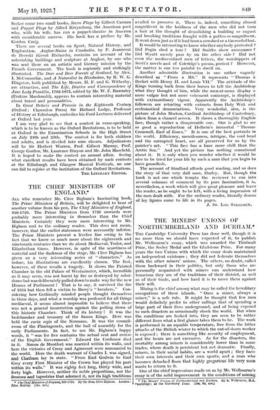THE CHIEF MINISTERS OF ENGLAND.*
ALL who remember Mr. Clive Bigham's fascinating book, The Prime Ministers of Britain, will be delighted to hear of another volume from his pen, The Chief Ministers of England, 920-1720. The Prime Ministers from 1720 onwards were probably more interesting in themselves than the Chief Ministers. Certainly they were more interesting to Mr. Bigham and to the ordinary reader. This does not mean, however, that the earlier statesmen were necessarily inferior. The Prime Ministers present a livelier line owing to the fact that we know so much more about the eighteenth and nineteenth centuries than we do about Mediaeval, Tudor, and Elizabethan times. However, in spite of the scantiness of material and the darkness of the stage, Mr. Clive Bigham has given us a very interesting series of " characters." As before, his illustrations are excellently chosen. The first, however, of these recalls a tragedy. It shows the Painted Chamber in the old Palace of Westminster, which, incredible as it may seem, was not burnt by fire or destroyed by subsi- dence but was deliberately pulled down to make way for the new Houses of Parliament That is to say, it survived the fire of 1834 but then fell a victim to Barry's " breakers." Con- sidering how Gothically minded people thought themselves in those days, and what a worship was professed for all things mediaeval, it seems almost impossible to believe that there was not a general insurrection against the pulling down of this historic Chamber. Think of its history It was the bedchamber and treasury of the Saxon Kings. Here was held the curia regis of the Normans. It was the council- room of the Plantagenets, and the hall of assembly for the early Parliaments. In fact, to use Mr. Bigham's happy words, it " was for five centuries the actual seat and centre of the English Government." Edward the Confessor died in it. Simon de Montfort was married within its walls, and here the victories of Crecy and Agincourt were announced to the world. Here the death warrant of Charles I. was signed, and Chatham lay in state. " From Earl Godwin to Earl Grey every First Minister of the Crown has played his part within its walls." It was eighty feet long, thirty wide, and forty high. However, neither its noble proportions, nor the frescoes and tapestries that adorned it, nor its high traditions • The Chief Ministers of 13nglattel, 920-1720. By the lion. Clive Bigham. London ; Tohu Murray. [21s. net.]
availed to preserve it. There is, indeed, something almost magnificent in the boldness of the men who did not turn a hair at the thought of demolishing a building so august and breaking traditions fraught with a pathos so magnificent. It went down just as if it had been a cowshed or a tin-roofed hut.
It would be interesting to know whether anybody protested Did Pugin shed a tear ? Did Smirke show annoyance ? Did Wyatt merely pass by on the other side ? Did not even the mediaevalized men of letters, the worshippers of Scott's novels and of Coleridge's poems, protest ? However, the matter is one too painful to dwell on.
Another admirable illustration is one rather vaguely described as " From a MS." It represents " Thomas a Becket with Henry II. and Louis VII." The attitude of the Kings turning baCk from their horses to tell the Archbishop what they thought of him, while the men-at-arms display a more vulgar but not more vehement contempt, is displayed with extraordinary vigour. Apparently the Archbishop's followers are retorting with extracts from Holy Writ and ecclesiastical denunciations. Very wonderful, also, is the picture of John Morton, Cardinal Archbishop of Canterbury, taken from a chancel screen. It shows a thoroughly English face, though rather a disagreeable one. One is glad to see so good a reproduction of Holbein's immortal " Thomas Cromwell, Earl of Essex." It is one of the best portraits in the world. Efficiency, mercilessness, intrigue, the cool head and the corrupted heart, arc all preserved for us by the painter's art. " This face has a haze more chill than the Arctic Sea." And yet the picture has nothing sensational about it. It is only when you wonder whether it would be nice to be tried for your life by such a man that you begin to have gooseflesh.
The account of Strafford affords good reading, and so does the story of that very dull man, Harley. But, though the book is not one which tempts the reviewer to run into several columns of comment by its pure fascination, it is, nevertheless, a work which will give great pleasure and leave the reader, as he ought to be left, with a living impression of the men dealt with. For the ordinary reader, literally dozens of lay figures come to life in its pages.
J. ST. Lou STRACIIEY.










































 Previous page
Previous page